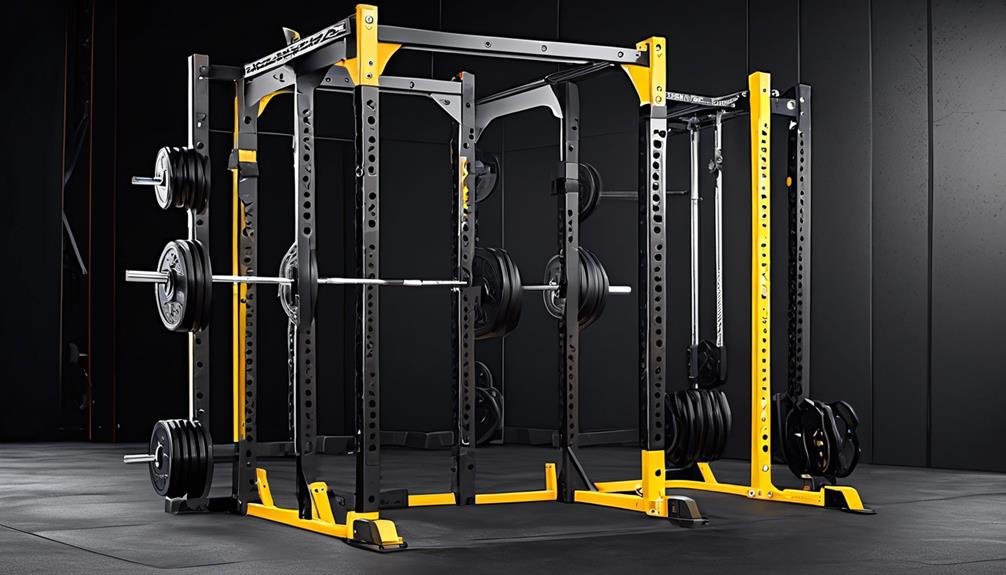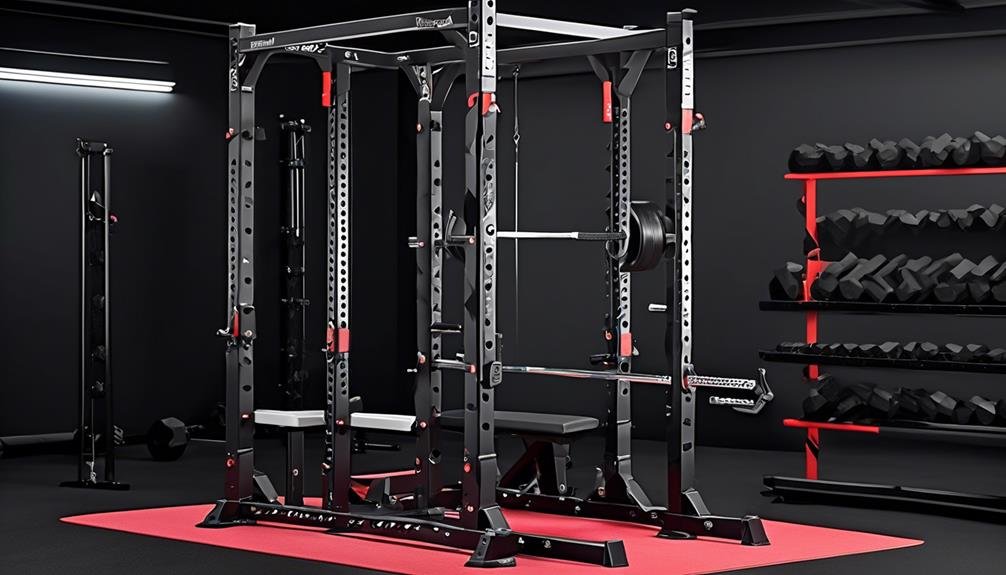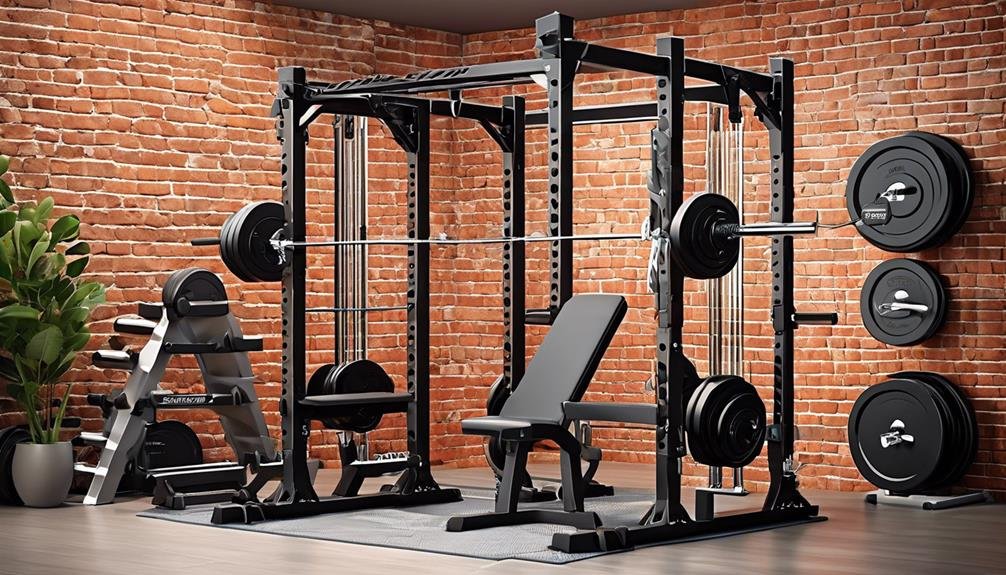Are you feeling lost in the vast array of power racks and squat racks available on the market? Well, fear not. Choosing the right rack for your space and needs may seem like a daunting task, but with a little guidance, you'll be on your way to finding the perfect fit.
So, where do you start? Let's begin by exploring the different types of racks and the factors you should consider when making your decision.
Key Takeaways
- Consider personal preferences and physical height when determining the rack height.
- Assess the available space and height restrictions in the gym area before choosing a rack.
- Look for a rack that offers sturdiness, weight capacity, and versatility to accommodate various exercises.
- Evaluate your budget and consider the long-term investment potential while balancing cost with features and durability.
Types of Racks
When choosing the right power rack or squat rack, it's important to consider the different types of racks available to suit your needs. There are several options to choose from, each with its own advantages and considerations.
The most popular and recommended option is the power rack. This type of rack offers versatility and safety, making it ideal for a wide range of exercises.
If you have limited space, you may want to consider folding racks. These racks can be folded into the wall when not in use, allowing you to maximize the space in your home or gym.
Another option is squat stands, which are stripped-down versions of power racks. They provide a cheaper alternative but offer less versatility.
For those looking for a smaller option, the half rack is a good choice. It's smaller and less deep than a power rack, providing a more solid base but sacrificing some stability and versatility.
Lastly, if you're a powerlifter, a combo rack may be the best option for you. These specialized racks are designed for powerlifting meets and feature adjustable uprights and a bench.
Consider the space you have available and the specific exercises you plan to do when choosing the type of rack that suits your needs.
Rack Height and Uprights
Consider your personal preferences, physical height, and the types of exercises you plan to do when determining the appropriate rack height and uprights for your power rack or squat rack.
The rack height and uprights are crucial factors to consider as they determine the overall functionality and usability of your rack.
When selecting the rack height, it's important to ensure that there's enough space for exercises such as pull-ups, overhead presses, and muscle ups. Take into account the available space in your gym area and the options offered by the company.
Basement gyms, for example, may have height restrictions that need to be considered. Additionally, the height of your ceiling may limit your rack selection and the inclusion of accessories like multi-grip pull-up bars.
Therefore, it's important to carefully assess your space and exercise requirements to ensure that the rack height and uprights of your power rack or squat rack meet your needs.
Power Rack Features

Now let's explore the features of power racks that make them an ideal choice for heavy lifting and versatile workouts. Power racks are designed to provide stability and support for your squat and other weightlifting exercises. They offer a range of features that enhance your workout experience and allow for a variety of exercises to target different muscle groups. Here are some key features to consider when choosing a power rack:
| Features | Benefits |
|---|---|
| Sturdiness | Provides a secure workout environment |
| Weight Capacity | Handles heavy loads for strength training |
| Versatility | Accommodates various exercises and variations |
| Accessories | Safeties, dip attachments, and pull-up bars |
| Footprint | Fits within your available space |
The sturdiness of power racks ensures that you have a solid and stable platform to perform your squats and other heavy lifting exercises. The weight capacity of a power rack is crucial to ensure it can handle the amount of weight you plan to lift. This includes considering the weight capacity of accessories such as hooks/safeties, dip attachments, and pull-up bars. The versatility of power racks allows you to perform a wide range of exercises, including classic movements like squats, bench presses, and pulls, as well as accommodating various other anaerobic training movements. Lastly, it's important to consider the footprint and usable area of the power rack to ensure it fits within your available space. By considering these features, you can choose a power rack that meets your needs and provides a safe and effective workout environment.
Budget Considerations
To effectively manage your budget when choosing a power rack or squat rack, it's important to carefully assess your financial range beforehand. Consider the initial cost of the rack as well as potential additional expenses for accessories and attachments. Look for racks that offer good value for money, balancing cost with features and durability. Evaluate the long-term investment potential, considering the rack's quality and potential for future expansions.
Exploring options for used or refurbished racks can potentially save on costs while ensuring quality.
Setting a budget range will help narrow down your options and prevent overspending. Take into account both the upfront cost of the power rack or squat rack itself, as well as any additional expenses you may incur for accessories and attachments. This could include items such as weight plates, barbells, or dip attachments. By considering these costs ahead of time, you can ensure that you have enough funds to fully equip your rack.
When comparing different power racks or squat racks, it's important to find a balance between cost and features. Look for racks that offer the necessary functions and durability without breaking the bank. Consider the materials used, weight capacity, and additional features such as pull-up bars or safety spotter arms. This will help you get the most value for your money.
In addition to the initial cost, think about the long-term investment potential of the rack. A high-quality rack with sturdy construction and the ability to accommodate future expansions can be a wise investment. This will allow you to upgrade or add attachments as your fitness needs evolve, saving you money in the long run.
Lastly, don't overlook the option of purchasing a used or refurbished power rack or squat rack. These racks can often be found at a lower cost while still maintaining good quality. Just be sure to thoroughly inspect the rack before purchasing to ensure it meets your safety standards.
Safety Features and Stability

When it comes to ensuring your safety and stability during intense workouts, it is crucial to choose a power rack or squat rack that offers reliable safety features and a sturdy build. Look for safety features such as safety pins, straps, and stabilizers to reduce the risk of injury during heavy lifts. These features provide an added layer of protection by catching the barbell if you fail to complete a rep. Additionally, choose a rack with a sturdy build and strong anchoring options to ensure stability during intense workouts. A solidly built rack will withstand heavy loads and prevent any wobbling or tipping. Consider the weight capacity of the rack, ensuring it can support your lifting needs and provide a secure environment. Opt for a power rack with adjustable safety bars and J-hooks, allowing for customized positioning to enhance safety and stability. This way, you can set up the rack to the appropriate height, ensuring the barbell is at the right level during your exercises. Finally, always ensure the rack's dimensions and footprint fit within your available space to prevent any potential hazards during use.
To help you understand the importance of safety features and stability, here is a comparison table that highlights key factors to consider when choosing a power rack or squat rack:
| Feature | Importance | Benefit |
|---|---|---|
| Safety pins | High | Prevent the barbell from falling, reducing the risk of injury |
| Straps | Medium | Provide additional support in case of barbell failure |
| Stabilizers | Medium | Improve rack stability and reduce wobbling |
| Sturdy build | High | Ensures the rack can handle heavy loads without tipping or wobbling |
| Strong anchoring options | High | Adds extra stability and prevents the rack from moving during workouts |
| Adjustable safety bars | High | Allows for customized positioning to ensure the barbell is at the right height |
Rack Recommendations
For optimal rack recommendations, consider factors such as your lifting style, available space, and the compatibility of attachments and accessories.
Here are some key points to keep in mind when choosing a power rack or squat rack:
- Space: Before purchasing a rack, assess the available space in your home or gym. Measure the area where the rack will be placed, taking into account the height, width, and depth of the rack. Ensure that there's enough space for you to comfortably perform exercises and move around the rack.
- Modular Design: Look for a rack that's modular and allows for future add-ons and attachments. This will give you the flexibility to customize your rack as your needs and training goals evolve. Consider the availability of accessories such as dip bars, pull-up bars, and weight plate storage options.
- Compatibility: Assess the compatibility of the rack with attachments and accessories from other manufacturers. This will expand your options and allow you to choose the best equipment for your specific needs. Check if the rack has standard-sized holes or if it requires proprietary attachments.
- Lifting Style: Consider your own lifting style and preferences when selecting a rack. Different racks offer various features such as band pegs, safety spotter arms, or adjustable J-cups that cater to different lifting techniques. Choose a rack that aligns with your training goals and preferences.
Frequently Asked Questions
Should I Get a Power Rack or Squat Rack?
You should get a power rack if you want versatility for various exercises and attachments. A squat rack is a good option if you primarily focus on squats and don't need the additional features of a power rack.
How Do I Choose a Power Rack?
To choose a power rack, consider your needs, space, and lifting style. Look for modularity, compatibility with attachments, and the right height and width. Evaluate different configurations and customize to suit your requirements.
How Big of a Space Do You Need for a Power Rack?
You'll need a space that's at least 8 feet tall and wide for a power rack. Consider additional room for movement and attachments. Make sure to check the specific requirements for the model you're interested in.
What Squat Rack Should I Get?
You should get a squat rack that suits your needs and space. Consider factors like versatility, safety features, and compatibility with attachments. Compare different types of racks to find the best fit for you.
Conclusion
In conclusion, choosing the right power rack or squat rack for your space and needs can be a daunting task. However, considering factors such as the type of rack, modularity, size, compatibility with attachments, personal preferences, and budget can help narrow down your options.
Additionally, paying attention to features, accessories, build quality, safety features, and stability is crucial. These factors will ensure that you choose a rack that not only meets your needs but also provides a safe and durable workout environment.
By doing thorough research and considering your specific goals and space, you can find the perfect rack that suits your needs. Take the time to compare different options, read reviews, and even try out different racks if possible. This way, you can make an informed decision and invest in a rack that will serve you well for years to come.





